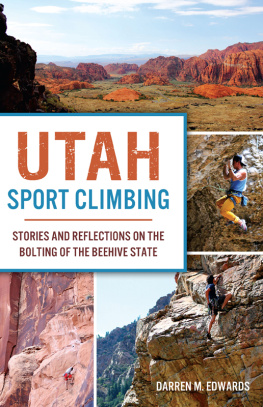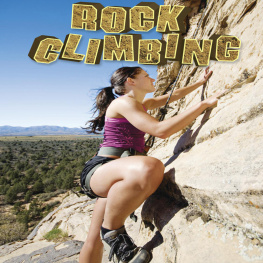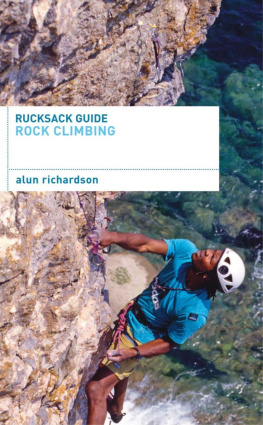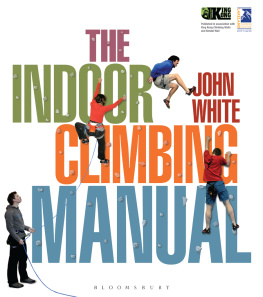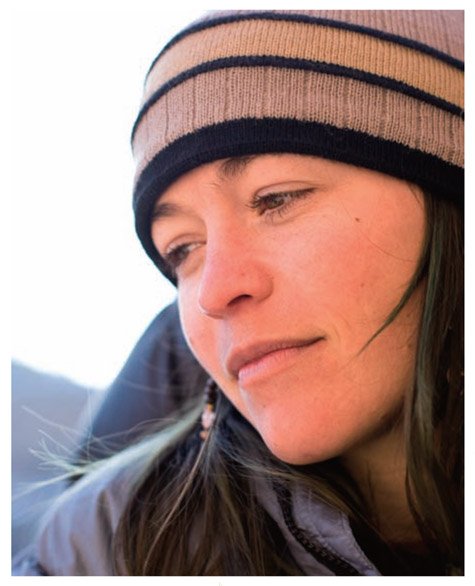about the author
As the first woman to on-sight 5.13d (Omaha Beach, Red River Gorge, Kentucky) and flash 5.14a (Hydrophobia, Mont Sant, Spain), Katie Brown has been an influential and ground-breaking climber. She began climbing at age thirteen and quickly dominated competition at the national and international level. Now in her twenties, she is a freelance writer and continues to travel the world as a professional climber.
Katie Brown liebacking a sandstone crack near Moab, Utah.
appendix a:
rock climbing glossary
aid: Means of getting up a climb using other than the actions of hands, feet, and body English.
aid climb: To climb using equipment for direct assistance, which allows passage over rock otherwise impossible using only hands and feet; opposite of free climb.
Aliens: A type of spring-loaded camming devices (SLCDs), the most popular types of anchors. See Friends.
anchor: A means by which climbers are secured to a cliff.
anchor matrix: The placement of anchors using various rigging systems.
arte: An outside edge or corner of rock, like the outer spine of a book, sometimes as large as a mountain ridge.
arm bar: A means of holding on to a wide crack; also called arm lock.
arm lock: See arm bar.
backstep: The climbing move of placing the outside edge of the foot behind, usually on a vertical hold.
bashie: A piece of malleable metal that has been hammered into a rock seam as an anchor; used in extreme aid climbing.
belay: Procedure of securing a climber by the use of a rope.
Beta: Specific information provided by one climber to another about how to do the moves on a route or boulder problem.
bi-doigt: A two-finger handhold.
Big Dudes: A type of spring-loaded camming devices (SLCDs), the most popular types of anchors. See Friends.
big wall: See wall.
bight: A loop, as in a bight of rope.
biner: See carabiner.
bolt: An artificial anchor placed in a hole drilled for that purpose.
bomber: Absolutely fail-safe (as in a very solid anchor or big, big handhold); sometimes called bombproof.
bombproof: See bomber.
bridging: See stemming.
bucket: A handhold large enough to fully latch onto, like the handle of a bucket.
buttress: An outside edge of rock thats much broader than an arte, definitely mountainsize.
cam: To lodge in a crack by counterpressure; that which lodges.
Camalots: A type of spring-loaded camming devices (SLCDs), the most popular types of anchors. See Friends.
carabiner: Aluminum alloy ring equipped with a spring-loaded snap gate; sometimes called biner or krab.
ceiling: A section of rock that extends out above your head; an overhang of sufficient size to loom overhead; also called a roof.
chalk: Standard equipment used to soak up finger and hand sweat on holds, although not allowed at certain areas.
chickenhead: A bulbous knob of rock.
chimney: A crack of sufficient size to accept an entire body.
chock: See nut.
chockstone: A rock lodged in a crack.
Class 1: Mountain travel classification for trail hiking.
Class 2: Mountain travel classification for hiking over rough ground, such as scree and talus; may include the use of hands for stability.
Class 3: Mountain travel classification for scrambling that requires the use of hands and careful foot placement.
Class 4: Mountain travel classification for scrambling over steep and exposed terrain; a rope may be used for safety on exposed areas.
Class 5: Mountain travel classification for technical free climbing where terrain is steep and exposed, requiring the use of ropes, protection hardware, and related techniques.
Class 6: Mountain travel classification for aid climbing where climbing equipment is used for balance, rest, or progress, denoted with a capital letter A followed by numerals 0 to 5 (for example, 5.9/A3, meaning the free-climbing difficulties are up to 5.9 with an aid section of A3 difficulty). Also see Yosemite Decimal System (YDS).
clean: Routes that are variously free of vegetation or loose rock, or where you dont need to place pitons; also the act of removing chocks and other gear from a pitch.
cling grip: A handhold where you grasp an edge with your fingers.
cold shut: A relatively soft metal ring that can be closed with a hammer blow; notoriously unreliable for withstanding high loads; commonly found as anchors atop short sport climbs.
cordelette: Standard tackle that facilitates equalizing the load between two or more anchors. A sixteen-foot section of six-millimeter Spectra is tied into a loop and clipped through all the anchor pieces, then tied off to create a single tie-in point, forming separate and equalized loops.
crack: Type of irregularity on the stone.
crimper: A small but positive sharp edge.
crux: The most difficult section of a climb or pitch, typically marked on topos with the difficulty rating.
difficulty rating: See Classes 16, GradesIVI, R-rated, X-rated, and Yosemite Decimal System (YDS).
dihedral: An inside corner of the climbing surface, formed by two planes of rock, like the oblique angle formed by the pages in an open book.
downclimb, downclimbing: A descent without rope, usually when rappelling is unsafe or impractical.
drag: Used in reference to the resistance of rope running through carabiners.
dynamic: Lunge move; sometimes called a dynamo or mo.
dynamo: See dynamic.
dyno: A move where all points of contact leave the wall as the climber jumps up to reach a hold that could not otherwise be reached.
edge: A small hold ledge or the act of standing on an edge.
edging: The climbing move of placing the very edge of the shoe on any hold that is clear-cut.
exposure: A relative situation where a climb has particularly noticeable sheerness.
flake: Type of irregularity on the stone.
flag: Using a limb as a counterbalance.
flash: Free climbing a route from bottom to top on first try.
footwork: The art and method of standing on holds.
free: See free climb.
free ascent: See free climb.
free climb: The upward progress gained by a climbers own efforts, using hands and feet on available features, unaided or free of attending ropes and gear. Rope is only used to safeguard against injury, not for upward progress or resting; opposite of aid climb; also called free or free ascent.
free solo: Free climbing a route alone from bottom to top on your first try.
Friends: Spring-loaded camming devices (SLCDs) that can be used in all situations; the most popular type of anchors. These include Aliens, Big Dudes, Camalots, Quad Cams, and Three-Cam Units (TCUs).
frog step: A climbing move where you bring one foot up, then the other, while keeping your torso at the same level, forming a crouched, or bullfrog, position.


